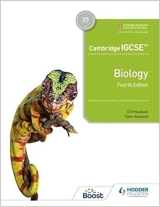Chapter 11. Digestion, absorption and use of food
Page 98
1. The three functions shown are storage, digestion and absorption.
2. a The pancreas pours pancreatic juice into the duodenum.
b The salivary glands secrete saliva into the mouth.
3. Epithelium, circular muscle, longitudinal muscle.
Page 101
1. The airways are cut off. The soft palate closes the nasal cavity; the tongue, the epiglottis and muscles in the glottis, seal the top of the windpipe.
2. The solid food has to be broken down to a liquid from which the nutrients can be absorbed through the gut wall. Plants build their food from carbon dioxide water and minerals. They do not take in solids.
3. a Starch is digested in the mouth, the duodenum and the small intestine.
b Protein is digested in the stomach, the duodenum and the small intestine.
4. Pepsin acts on only one kind of substance (protein) and works best at a particular pH.
Page 103
1. a Starch is digested to glucose.
b Proteins are digested to amino acids.
c Fats are digested to fatty acids and glycerol.
2. The small intestine is long; it is lined with vast numbers of villi. Both these factors give the small intestine a large absorbing surface. The epithelium is thin, which allows rapid diffusion or active uptake of digested food. There are numerous capillaries to carry off the digestion products.
3. In the stomach the enzyme, pepsin, breaks the protein down to form peptides. In the duodenum and small intestine the peptides are broken down further, by enzymes, to form amino acids. The amino acids are absorbed through the intestinal lining to reach blood vessels which join up to form the hepatic portal vein. This vein carries the amino acids to the liver which makes them into new proteins or alters their composition so that they can be used for energy production.
4. In the duodenum the starch molecules are broken down to glucose. In all the cells of the body, glucose is broken down to carbon dioxide and water by respiration.
Page 105
1. The liver controls the glucose concentration of the blood by changing excess glucose to glycogen. It controls the amino acid level by converting the excess into substances which can be oxidised to provide energy. By detoxifying potentially harmful substances that have been absorbed in the small intestine, the liver prevents their entry into the bloodstream. The liver prevents harmful levels of haemoglobin building up by removing and storing the iron from the haemoglobin molecule.
2. The liver makes bile, which helps the digestion of fats in the duodenum and intestine.
3. A large fluctuation in the concentration of solutes such as glucose could upset the osmotic equilibrium of cells. If hormones were allowed to build up they could adversely affect the ways cells function. Large variations in plasma proteins could affect the clotting processes.
Page 107
1. Enzymes are proteins. When proteins are heated above about 50 degrees C they are denatured and lose their shape. Boiling destroys the activity of an enzyme and this makes it a good experimental control.
2. The cloudiness is due to solid particles of egg white. When they are digested to soluble substances, the cloudiness disappears.
3. You could prepare a series of test tubes as in tube C and put them in controlled temperature water baths from say, 5 degrees C to 35 degrees C to see which one cleared first.
4. The variables are (a) the presence or absence of hydrochloric acid (tubes A and C), and (b) the presence or absence of unboiled pepsin (tubes C and D). (a) Tube A could be the control;
(b) tube D could be the control.
5. Starch is a carbohydrate. It could not be an enzyme. A knowledge of the molecular structure of starch (p.12) reveals that it is made up of a chain of glucose molecules so it is the more likely source of glucose.
6. This question depends on personal data, so no general answer can be given. |
Downloads
Download the answers in PDF format below
Section 1, Chapters 1-5
Section 2, Chapters 6-9
Section 3, Chapters 10-12
Section 3, Chapters 13-17
Section 3, Chapters 18-20
Section 4, Chapters 21-24
Section 5, Chapters 25-27
Section 5, Chapters 28-29
Section 6, Chapters 30-34
Section 6, Chapters 35-37
Section 7, Chapters 38-39
Section 8, Chapters 40-41
|
